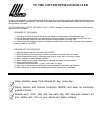
MAINTENANCE
INTERSTATER 02/11 Maintenance Section 5-27
© 2011 Alamo Group Inc.
MAINTENANCE
SEASONAL CLUTCH MAINTENANCE
It is important that the clutch lining plates slip when an obstacle or load heavier than clutch setting is
encountered. Therefore, if the machine sits outside longer than 30 days and is exposed to rain and/or humid
air it is important to make sure that the clutch lining plates are not rusted/corroded together. Before using the
mower use the following procedure to make sure the clutch will slip and give the overload protection required.
1. Loosen nuts on springs until the springs can freely rotate, yet remain secure on bolts.
2. Attach mower to tractor and start the tractor. Set the engine speed at 1200 RPM.
3. Mark outer plates as shown in.
4. Engage the PTO (approximately one second) and then quickly disengage it. The friction lining plates
should break loose (check the mark).
5. Turn tractor off and tighten the nuts on the springs to their original position of 1-5/16" compressed spring
length.
A double wing Interstater with 74" wing mowers will require approximately 26 gallons of oil to fill the hydraulic
tank, hoses, cylinders and cooling tubes in the mower deck. An Interstater with 60" wings will require less oil
and with 88" wings will require more oil. The Hydraulic tank only holds 15 gallons of oil and you can not add
enough oil to the tank the first time to completely fill the system. Oil should be changed after the first 200 hours
of operation and every 400 hours of 12 months of operation thereafter.
The following filling instructions must be carefully followed to prevent pump cavitation and instant pump failure.
1. After the Interstater mower is completely assembled to the tractor and with the wings on the ground, fill the
mower hydraulic tank above the oil level sight gauge approximately 5" or 1" below the top of the tank.
2. Start the tractor and run it for 30 to 45 seconds and then turn it off.
3. Check the oil level in the sight gauge. If no oil is seen, add oil to bring the level up to the sight gauge.
NOTE: Do not fill the tank with oil above the level of the sight gauge after the first filling. Overfilling the tank
with oil after the initial filling may result in oil being discharged through the air filter on top of the hydraulic tank.
4. Start the tractor and run it for 2 minutes and then turn it off.
5. Again check the oil level in the sight gauge. If the oil level is in the sight gauge, the unit is ready to run. If
no oil is seen, add oil to bring the level up to the sight gauge.
6. Repeat steps 4 and 5 as required until the oil level stabilizes at the level of the sight gauge.


















